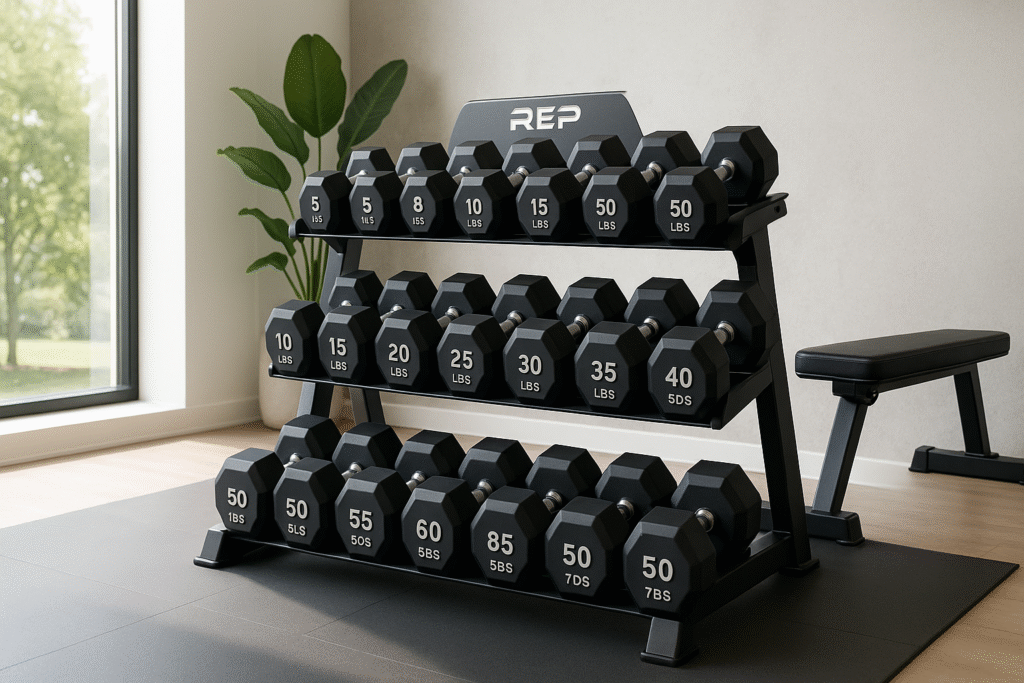Best Non Toxic Dumbbells: Ever wondered if your gym equipment could harm your health? You probably saw Prop 65 warnings on dumbbells or smelled a chemical odor on vinyl-coated weights. In fact, “your weights may be hiding chemicals and plasticizers that could be potentially toxic to your system,” as one clean‑living fitness guide warns. That’s a problem if you’re trying to build muscle and stay healthy. In this guide, I’ll show you how to avoid harmful materials, what safe dumbbell materials to choose, top product picks, and more, so your gains stay green and clean.
Materials to Avoid in Dumbbells
Not all dumbbells are created equal. Cheap vinyl, PVC, and painted coatings often contain hidden toxins. Watch out for these materials:
PVC/Vinyl coatings
Common on budget dumbbells and kettlebells, PVC can leach phthalates (softening agents) that act as endocrine disruptors, causing asthma, infertility, developmental issues, and cancer. PVC production also emits dioxins, lead, cadmium, and other pollutants.
Phthalates and Plasticizers
Found in many “rubber” or “soft touch” coatings, phthalates aren’t chemically bound and can migrate into the air or your hands. Over time, these chemicals accumulate in your body with well-known hormone-disrupting effects.
Lead and Heavy Metals
Sometimes added to paints or stabilizers, lead (or cadmium) in coatings can be toxic. Prop 65 tests have flagged old or low-quality weights for lead content. Any dumbbells with a noticeable metallic sheen or thick paint should be checked—if they lack a non-toxic certification, they might not be free of lead-based paints.
Key Takeaway
Avoid dumbbells with residue or strong chemical smells, bright vinyl wrappers, or plasticized grips. As a rule, avoid inexpensive neoprene or coated sets with Prop 65 warnings on the label. (In the U.S., that warning sign means something in them is linked to cancer or harm)
Safe Dumbbell Materials
Instead, look for inert materials and high-quality coatings. Good options include:
Stainless Steel or Cast Iron
Bare metal weights (or those with a baked enamel) are chemically inert and won’t off-gas. They don’t contain plasticizers, so they’re the safest choice for sensitive lifters.
Natural Rubber or Silicone
100% rubber (or food-grade silicone) is generally safe. Natural latex has no added toxins (except if you have an allergy), and silicone has virtually no odor or plasticizers. Avoid generic “black rubber” since that often means SBR or recycled rubber with hidden chemicals.
Urethane / TPU
Urethane (often labeled TPU) is a rigid, non-PVC polymer used on premium dumbbells. High-grade TPU can be made without phthalates. It’s odorless, abrasion-resistant, and won’t flake off. (Rogue and REP urethane dumbbells are solid steel with a thick urethane shell.)
Wood or Stone
Some boutique gyms use wooden or marble weights for light sets or decor. These are naturally non-toxic (avoid formaldehyde in any paint!). Solid wood handles or stone-clad kettlebells add character and are safe.
In Summary
Opt for stainless steel, cast iron, silicone, natural rubber, or urethane over anything with vinyl or cheap plastic. The MyChemicalFreeHouse guide advises: “Steel – bare metal does not off-gas and is the safest option… Silicone…is certainly the safest [plastic/rubber]”. Even polypropylene (PP) is relatively inert (no added BPA or phthalates). When in doubt, choose “no-plastic” materials and simple construction.
Best Non-Toxic Dumbbells: Top Picks
If you’re ready to upgrade, here are some of the best non-toxic dumbbells you can buy. (These are affiliate links, so I may earn a small commission if you purchase through them at no extra cost.)
REP Fitness Urethane Dumbbell
Solid steel with a urethane coating. These gym-quality rounds are ultra-tough and abrasion-resistant, resisting nicks or cracks over years of use. The chrome, knurled handles provide a secure grip at any weight. Sold in 5–150 lb pairs, REP’s urethane bells are virtually odor-free and protect your floors. (See my Best Urethane Dumbbells 2025: Top Sets & Brands Reviewed for more.)
PAPABABE HEX Dumbbells
These hex-head dumbbells use 100% solid cast-iron heads fully encased in thick, odorless rubber. They’re sold in pairs from 2.5 lb up to 25 lb (heavier sets are available) and have knurled chrome handles for a secure grip. The rubber coating is phthalate—and PVC-free, so it carries no toxic smell. Hexagonal ends prevent rolling and protect floors.
XMark Rubber Hex Dumbbells
These hex dumbbells have solid steel cores with thick rubber sleeves and are sold as a 10–50 lb (10-pair) set. The rubber cover dramatically reduces noise and protects floors, while ergonomically knurled chrome handles provide a comfortable, non-slip grip. XMark uses high-quality rubber that is effectively odor-free, eliminating unpleasant odors. (A compact 2-tier rack is also available to keep the set organized.)
The links above allow you to check current prices and read user reviews. I also cover more eco-picks in my Best Adjustable Dumbbells 2025 and Best Dumbbells Under $1000 guides.
Maintenance & Storage Tips
Even non-toxic coatings need care to stay pristine. Follow these tips to extend their life and keep them safe:
Wipe clean after each use
Sweat and dirt can corrode metal. Use a damp cloth or mild soapy water to clean off residue. A soft, wet towel is ideal for urethane-encased dumbbells. (One tip: WD-40 works well to clean chrome handles without harming the finish.)
Avoid harsh chemicals
Never use bleach, ammonia, Windex, or other strong solvents on your weights. These can strip away protective coatings or leave toxic residue. Stick to gentle cleaners or sports equipment wipes.
Store on a rack
Don’t toss dumbbells on the floor. A sturdy dumbbell rack keeps them off damp or dirty surfaces. Many racks have padded holders to protect the weight’s coating. Good storage also prevents accidental rust from moisture.
Wipe down metal parts.
If you have bare steel or cast iron dumbbells, lightly oil them occasionally to prevent rust. A drop of 3-in-1 oil or anti-rust spray on the handle works wonders. Even a little leather conditioner on cast-iron bars helps seal them.
Inspect regularly
Check for loose bolts, cracked rubber, or peeling paint every few months. Tighten any set screws and replace worn grips. Never use equipment with damaged components – it’s a safety hazard.
Handle with care
Don’t drop or slam dumbbells on the floor. Repeated impacts can dent metal and crack rubber/urethane shells. Also, avoid dragging them across rough surfaces.
Protect from extremes
Keep weights out of direct sunlight or very hot/cold areas. UV light and heat can dry or shrink some rubber/plastic parts. Store at room temperature to preserve any rubber or plastic coating.
With some care, your non-toxic dumbbells will look and perform like new for years. This translates to better durability and cost savings (and less need to throw them out).
Certifications & Labels to Look For
Unlike food or toys, gym equipment rarely has easy “organic” seals. But you can still check a few certifications and labels:
RoHS / CE / FCC
Heavy metals (lead, cadmium, mercury, etc.) are limited if the product mentions RoHS or CE. These are mainly EU standards for electronics, but some high-end fitness gear (especially smart/digital equipment) may comply. A RoHS stamp generally indicates that the materials avoid hazardous substances.
REACH
This EU regulation bans certain chemicals in manufactured goods. Under REACH, many phthalates and toxic heavy metals are restricted. If a manufacturer touts “REACH compliant,” it suggests fewer contaminants in coatings or plastics.
Prop 65 (CA)
In the U.S., California’s Prop 65 requires a warning label if the item contains any of ~900 listed toxins. Ironically, the absence of a Prop 65 warning is a good sign. A dumbbell with no Prop 65 label likely avoids phthalates, BPA, and lead additives. Conversely, read the fine print if you see the Prop 65 triangle. It should list at least one chemical (e.g., “This product contains lead…”).
Product Safety Ratings
While not chemical-specific, look for durability or safety certifications like ISO 9001 or ASTM ratings when available. Though these focus on build quality, a well-made weight is less likely to use shoddy materials.
In practice, few dumbbells will wear a big RoHS/CE logo. Instead, scrutinize the spec sheets or FAQ on the seller’s site. Search for phrases like “phthalate-free,” “lead-free,” “non-VOC paint,” or the certifications above. Any transparency is a plus. (Side note: the MyChemicalFreeHouse guide reminds us that “the best non-toxic dumbbells… are made of materials that don’t off-gas, have an odor, or contain chemicals of concern”.)
Standard vs. Non-Toxic Dumbbells
How do regular gym dumbbells stack up against eco-friendly ones? Here’s a quick comparison:
Standard Dumbbells
Usually cast iron or steel with neoprene, vinyl, or basic rubber coatings. They’re affordable and quiet (rubber absorbs sound). But cheap rubber can off-gas odors and soften over time. Vinyl hex sets often crack under sun exposure and may carry a chemical smell. Painted iron bars (like cheap spray-painted sets) risk chipping paint and rust. In short, low-cost sets often hide phthalates or leaded paint.
Non-Toxic Dumbbells
Made with premium materials (no “yellow” PVC or cheap rubber). For example, urethane-coated steel remains odour-free and resists aging. Stainless or silicone dumbbells won’t off-gas at all. These will keep their appearance and integrity much longer. (Strength Warehouse notes that urethane weights maintain a “clean, polished look” even after years, while rubber can start to crack.)
Cost & Durability
Non-toxic dumbbells often cost more upfront. Steel or urethane sets can run 2–5× the price of basic rubber dumbbells. However, their durability and health benefits can justify the investment. Over time, cheaper sets may need replacement, whereas a one-time quality purchase (urethane/silicone) improves longevity.
In short, standard dumbbells are fine if budget is king, but weigh the trade-off: you’ll likely give up air quality and lifespan. Non-toxic dumbbells cost more but reward you with peace of mind and durability. These safer materials reduce irritation and odor issues for senior users or those with sensitivities. (If you’re interested in adjustable options for seniors or limited space, see my Best Adjustable Dumbbells for Seniors and Adjustable Dumbbells 2025 guides.)
Testing Dumbbell Toxicity Before You Buy
If you are not sure if a new dumbbell set is genuinely safe, then use these steps:
Read the Specs
Check the product description for materials. Does it say “PVC-free,” “phthalate-free,” or list the coating? Beware of vague terms.
Look for Labels
See if the listing mentions RoHS/CE or “no Prop 65 chemicals.” A lack of any toxin warning is a good sign.
Check Reviews and Q&A
Customers often note smells or weird odors in reviews. If multiple people mention a chemical smell or headaches after use, steer clear.
Contact the Brand
If unclear, email or call the manufacturer. Ask specifically about heavy metals or plasticizers in the coating. Reputable brands often provide a Material Safety Data Sheet (MSDS) or details.
Simple At-Home Tests
You can do a quick sniff test – strong plastic or rubber smells mean chemicals are present. For heavy metals, there are lead-test swabs (sold in hardware stores) you could rub on the handle or paint to see if lead is detected. This isn’t foolproof, but it can catch apparent problems.
Prop 65 Labels
If buying in-store, look for a WARNING label. Manufacturers must list some chemicals if they’re on the Prop 65 list. If you see no warning label on the dumbbells or packaging, this suggests compliance.
Above all, use common sense: a cheap price or suspiciously vivid colors (bright green, pink, etc.) might mean vinyl. Instead, favor transparency about materials.
Best Non Toxic Dumbbells: Conclusion
Switching to the best non-toxic dumbbells is one of the smartest moves for your home or gym in 2025. Avoiding PVC, phthalates, and lead and opting for stainless steel, silicone, or urethane-coated weights will minimize exposure to harmful chemicals. These eco-friendly dumbbells may cost more initially, but they last longer and keep your workout space cleaner and safer. Follow the tips above to maintain them, and always look for certifications or labels that hint at chemical safety.
For more on strength gear, check out my other guides – from Adjustable Dumbbells for Seniors to the Ultimate Guide to Loadable Dumbbells. If you found this article helpful, follow me for honest fitness gear reviews and updates. Stay strong, stay healthy, and lift with confidence in 2025!
Affiliate Disclosure: Some links above are affiliate links. I earn a small commission at no extra cost if you purchase through these links.

Mohammad Nazif Uddin is a Marketing and Supply Chain Management student and fitness enthusiast with over 5 years of bodybuilding experience. As the founder of Muscle Theory, he shares practical insights on fitness supplements to help others make informed choices and achieve their goals safely.

